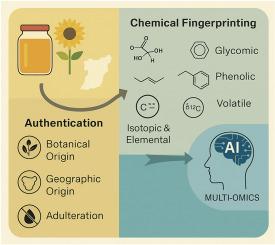The molecular identity of honey: toward reliable biochemical authentication
IF 15.4
1区 农林科学
Q1 FOOD SCIENCE & TECHNOLOGY
引用次数: 0
Abstract
Background
Honey fraud is a pervasive global challenge that compromises food safety, consumer trust, and the economic sustainability of apicultural systems. Despite honey's growing market value and well-recognized functional properties, current authentication practices remain hindered by fragmented biochemical marker panels, inconsistent analytical protocols, and limited regulatory alignment.
Scope and approach
This commentary evaluates how multi-omic profiling, including glycomic, phenolic, volatile, isotopic, and elemental signatures, can be transformed into reproducible biochemical fingerprints for honey authentication. Advances in high-resolution techniques (UHPLC-HRMS, GC-MS, NMR, FTIR, and RAMAN) combined with artificial intelligence (AI), particularly deep learning and federated modeling, offer unprecedented classification accuracy, scalability, and adaptability across production systems. We further explore the integration of harmonized sampling practices (“Good Apicultural Sampling Practice”), open-access reference libraries, interlaboratory validation, and digital traceability enablers such as blockchain, Big Data, and the Internet of Things (IoT).
Key findings and conclusions
Embedding explainable AI within authentication workflows enhances interpretability and regulatory acceptance, while blockchain and IoT provide tamper-resistant, real-time traceability across the supply chain. Together, these Industry 4.0 technologies can transform honey authentication from a retrospective laboratory task into a proactive surveillance system. By aligning robust science with transparent digital infrastructures and inclusive governance mechanisms, honey markets can move toward standardized, trusted frameworks that protect consumers, reward legitimate producers, and preserve the biodiversity and cultural heritage that underpin honey's unique identity.

蜂蜜的分子鉴定:迈向可靠的生化鉴定
蜂蜜欺诈是一个普遍存在的全球性挑战,它危及食品安全、消费者信任和养蜂系统的经济可持续性。尽管蜂蜜的市场价值不断增长,功能特性也得到了广泛认可,但目前的认证实践仍然受到零散的生化标记面板、不一致的分析方案和有限的监管一致性的阻碍。范围和方法本评论评估了多组学分析,包括糖、酚、挥发性、同位素和元素特征,如何转化为可重复的生物化学指纹,用于蜂蜜认证。高分辨率技术(UHPLC-HRMS, GC-MS, NMR, FTIR和RAMAN)的进步与人工智能(AI),特别是深度学习和联合建模相结合,在生产系统中提供了前所未有的分类准确性,可扩展性和适应性。我们进一步探讨了协调抽样规范(“良好的养蜂抽样规范”)、开放获取参考图书馆、实验室间验证和数字可追溯性使能器(如区块链、大数据和物联网(IoT))的整合。在身份验证工作流程中加入可解释的人工智能增强了可解释性和监管接受度,而区块链和物联网则提供了整个供应链的防篡改、实时可追溯性。总之,这些工业4.0技术可以将蜂蜜认证从回顾性实验室任务转变为主动监控系统。通过将强有力的科学与透明的数字基础设施和包容性治理机制结合起来,蜂蜜市场可以朝着标准化、可信赖的框架发展,从而保护消费者,奖励合法生产者,并保护支撑蜂蜜独特身份的生物多样性和文化遗产。
本文章由计算机程序翻译,如有差异,请以英文原文为准。
求助全文
约1分钟内获得全文
求助全文
来源期刊

Trends in Food Science & Technology
工程技术-食品科技
CiteScore
32.50
自引率
2.60%
发文量
322
审稿时长
37 days
期刊介绍:
Trends in Food Science & Technology is a prestigious international journal that specializes in peer-reviewed articles covering the latest advancements in technology, food science, and human nutrition. It serves as a bridge between specialized primary journals and general trade magazines, providing readable and scientifically rigorous reviews and commentaries on current research developments and their potential applications in the food industry.
Unlike traditional journals, Trends in Food Science & Technology does not publish original research papers. Instead, it focuses on critical and comprehensive reviews to offer valuable insights for professionals in the field. By bringing together cutting-edge research and industry applications, this journal plays a vital role in disseminating knowledge and facilitating advancements in the food science and technology sector.
 求助内容:
求助内容: 应助结果提醒方式:
应助结果提醒方式:


